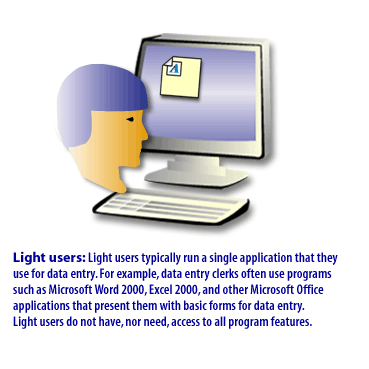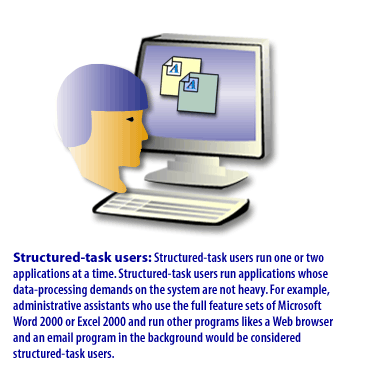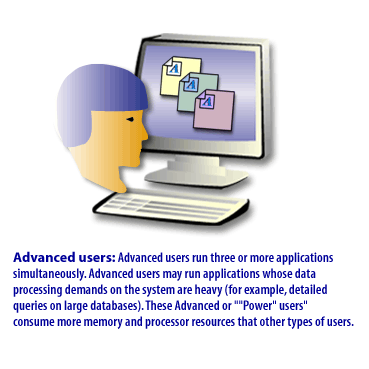| Lesson 6 | Determine server configuration to support users |
| Objective | Define the server configuration necessary to support users. |
Determine Server Configuration to support Users
Because all application processing takes place on the server, a server running Terminal Services normally requires more server resources per user than a computer running Windows 2000 Server. Ensuring that your server can accommodate your user base is crucial. To determine how powerful a Terminal Server must be to support users, you should consider the following factors:
- User characteristics
- Server system configurations
- Peripheral devices
Evaluating User Characteristics
Usage patterns of computer users can have a significant impact on the performance of Terminal Services. Most computer users can be placed in one of three categories described in the following user-characteristics.



Examining Server System Configurations
Before you install Terminal Services, consider the following system recommendations:
File system: It is recommended that you install Terminal Services on a partition that is formatted with the NTFS file system. NTFS provides security for users who all may be able to view the folder trees of other users in a multiple-session environment. You can use the local security provided only on NTFS partitions to prevent users from exploring the contents of other users' folders.
File system: It is recommended that you install Terminal Services on a partition that is formatted with the NTFS file system. NTFS provides security for users who all may be able to view the folder trees of other users in a multiple-session environment. You can use the local security provided only on NTFS partitions to prevent users from exploring the contents of other users' folders.
Click the learning bridge icon if you would like to review the NTFS file system. Server type: It is recommended that you install Terminal Services on a member server but not on a domain controller. Installing Terminal Services on a domain controller can hinder the performance of the server because of the additional memory, network traffic, and processor time that it requires to perform the tasks of a domain controller in a domain. In addition, there may be security risks inherent in placing a Terminal Server on a domain controller.
The Terminal Server should have at least 128 MB of RAM. The amount of RAM required to run a Terminal Server optimally will depend on the number of users simultaneously accessing the server as well as the types of activities the users perform on the server.
The Terminal Server should have at least 128 MB of RAM. The amount of RAM required to run a Terminal Server optimally will depend on the number of users simultaneously accessing the server as well as the types of activities the users perform on the server.
Activities users Perform on Server
For each light user, you should add 10 MB of RAM and for each heavy user you should add at least 21 MB of RAM. You do not necessarily need to add the amount of RAM based on how much system memory each program requires;if multiple users access the same application, they are able to use the same shared .dlls already loaded into memory. 32-bit Windows programs are designed to work most efficiently with this code-sharing scheme, and therefore it becomes more important that you use only 32-bit Windows applications in Terminal Sessions. The processor type can be important depending upon the type of applications run in a Terminal Session. If you have several users who are running graphics manipulation programs or statistical simulations, then processor usage will become an issue. Users of basic Microsoft Office-type programs do not consume much in terms of processor resources.
Processor resources tend to scale in a linear fashion. So, if you want to support twice as many users and provide the same level of processing availability, you can add a second processor. Even if you do not require multiple processors at the present time, it is an excellent idea to buy a multiple processor system board that supports at least two, and preferably four, processors. This will enable you to add processors as the need arises, without having to replace the motherboard.
Note: Purchasing a system that supports multiple processors, even if you initially purchase only one processor, allows you to add capacity easily as your requirements grow.
Processor resources tend to scale in a linear fashion. So, if you want to support twice as many users and provide the same level of processing availability, you can add a second processor. Even if you do not require multiple processors at the present time, it is an excellent idea to buy a multiple processor system board that supports at least two, and preferably four, processors. This will enable you to add processors as the need arises, without having to replace the motherboard.
Peripheral Devices that Affect Performance
Peripheral devices can also affect the performance of a server running Terminal Services: Hard disks:Disk speed is critical for Terminal Server performance. Small Computer System Interface (SCSI) disk drives have significantly better throughput than other types of drives. For highest disk performance, consider using a SCSI RAID controller. RAID (Redundant Array of Independent Disks) controllers automatically place data on multiple disks to increase disk performance and improve data reliability.
The RAID controller will allow for simultaneous multiple disk reads and writes. Consider using RAID 5 for both speed and fault tolerance advantages. Network adapter: A high-performance network adapter is recommended, especially if users require access to data that is stored on network servers. Using multiple adapters can significantly increase network throughput. However, you should analyze whether adding additional adapters would in fact provide improved performance. If the Terminal Server already has a Fast Ethernet adapter and its local segment has reached capacity, adding a second Fast Ethernet card on the same segment will not confer any bandwidthcadvantage. Multiport asynchronous communication adapter: If a multiport asynchronous communication adapter is installed for supporting dial-up users, be sure to use an intelligent (microprocessor-based) adapter to both reduce interrupt overhead on the processor and increase throughput. Most multiport adapters have their own processors that handle the interrupt traffic; the digiboard line of multiport devices is one of the best. The next lesson looks at licensing requirements.
Determine Server Configuration - Exercise
Click the Exercise link below to apply your knowledge about how server configuration affects installation of Terminal Services.Determine Server Configuration - Exercise